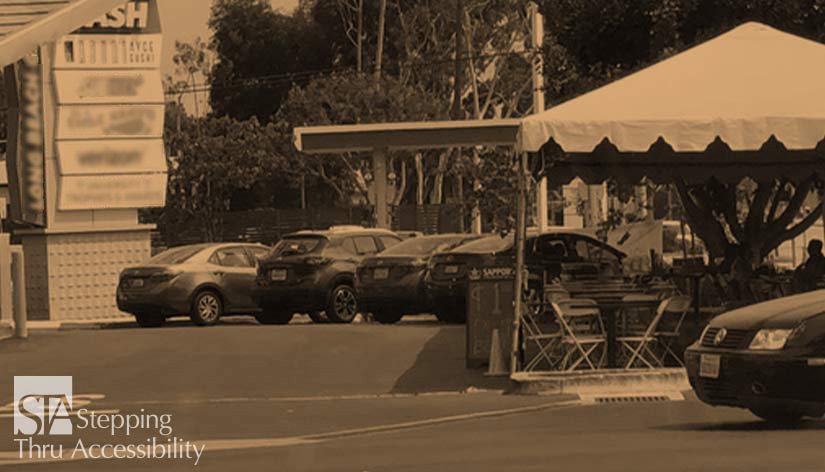Blog
Return to Blog »
Janis Kent, Architect, FAIA, CASp © September, 2020 With the continuation of our on-going plague, many restaurants are taking their seating area out to the public sidewalks, parking areas, and even onto the streets. While the concept of pop-up restaurants has been around for a while, it has evolved as a temporary outdoor add-on to existing restaurants while their interiors are closed to the public for health concerns. Many cities and towns are activating these public ways as pedestrian-only in order to allow this to happen. There are several items for business owners to be aware of in terms of access. If portions of the public sidewalk are being used, tables and seats can not infringe on the minimum sidewalk clearance. This means that for 5% of the seating required to be accessible, the 48″ deep clear floor space for these seats also can not impinge on the clearance. The distance from the edge of the table can be anywhere from 23″ to 31″ beyond the table depending upon clearance below (23″ to 29″ in California). If tables and seating are placed in parking lots, one has to be very careful that the number of accessible spaces remains proportional to the decreased number of parking spaces now being provided. And that would also be true for the van accessible spaces. So be careful about using the accessible parking spaces as part of the new exterior dining areas without a good understanding of the scoping requirements for accessible parking. The last situation I am seeing is that dining tables are placed within the street and what was street parking. One needs to be aware of the slope in these areas. This includes not only the slope to get to the accessible seating but also the 2% maximum slope at the accessible seating space itself. A. Many times a level platform is created for the seating area. In some cases these platforms are brought up to the same level as the sidewalk. Just be aware that this platform has an adequate edging to prevent someone from falling off of the sides. B. I am also seeing a curb ramp built from the sidewalk down to the street seating areas. This is fine, but just be aware that the sides of the curb ramp need to be protected to keep people from walking perpendicularly across this curb ramp as well as someone from slipping off of the edges. And the curb ramp itself is to be a slope of 8.33% maximum. If the slope is 5% or less it is not considered a ramp but the above two items are still of concern. C. The other option that I have been seeing is more of concern. That is where the platform is built higher than the sidewalk. By definition under ADA this is not a curb ramp since it is going up from the curb/sidewalk level, not down to the street. The ADA definition of a curb ramp is: Curb Ramp. A short ramp cutting through a curb or built up to it. If the slope is steeper then 5%, it is considered a pedestrian ramp. Under ADA this would require handrails if the height differential is greater than 6″. But under California’s CBC, it would require handrails even if 6″ or less. And in both cases, one needs to consider the edge conditions of either a 4″ height curb or a wheel guide rail at 4″ above the ramp surface so someone does not fall off. And with a pedestrian ramp, there are also requirements for top and bottom landing clearances as well as handrails. The issue is, many times building permits have not been required for these temporary venues. This then becomes more of a concern for the business owner to get this correct and accessible without any professional oversight. And even temporary venues are required to be accessible. So in the hurry to create opportunities for businesses to keep them afloat, one should not loose sight of also providing for access. Without permits or design professionals, this places a greater burden on the business owner to understand just what the requirements are and to implement them correctly. And one last item to be aware of – if a canopy is placed over these areas for weather protection, they will need to provide at least 80″ minimum clear height if located above circulation paths where people walk, and this includes the decorative scalloped edging as well. So if they exist, be sure to raise them to provide the minimum height clearances. Nothing in this article constitutes legal or design advice for a particular project or circumstance. Be aware that your local City or County may have additional requirements that are different or more restrictive than the State or Federal requirements. Also, this article is an interpretation and opinion of the writer which may vary for a particular project or due to other circumstances. It is meant as a general summary – current original regulations should always be reviewed when making any decisions. Specific advice by a qualified professional should be secured for a particular project or circumstance. © Janis Kent, FAIA, Architect, CASp 2020Pop-Up Restaurants and What You Need to Know About Access

Sidewalks
Parking Lots
Public Street